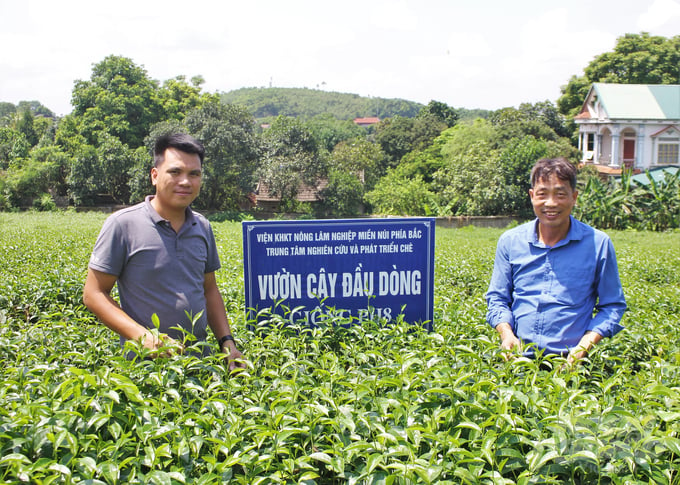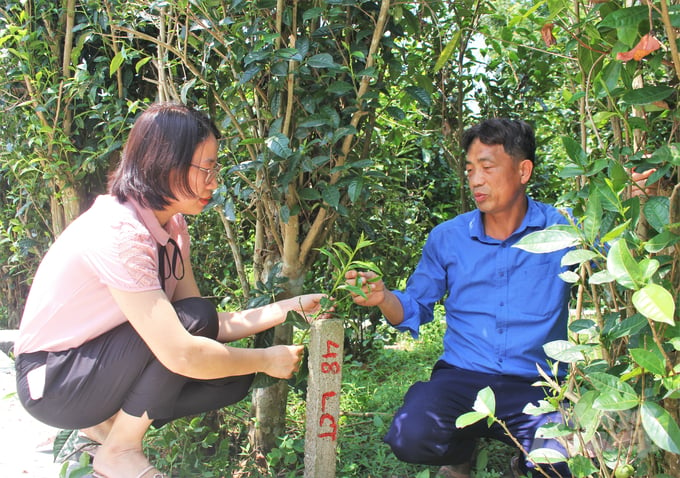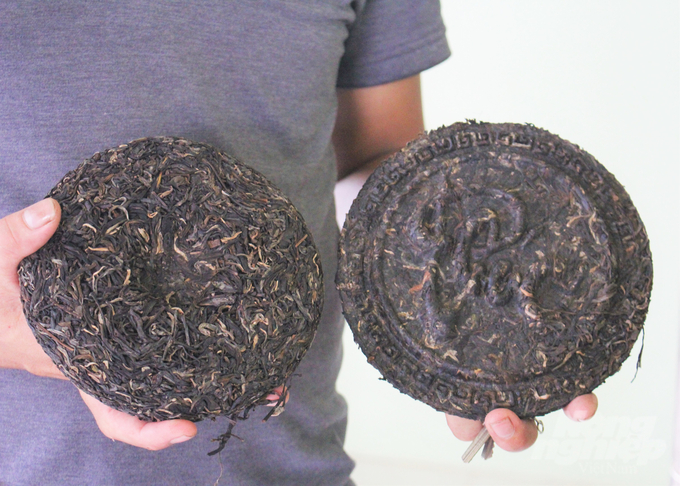May 26, 2025 | 03:49 GMT +7
May 26, 2025 | 03:49 GMT +7
Hotline: 0913.378.918
May 26, 2025 | 03:49 GMT +7
Hotline: 0913.378.918
The Northern Mountainous Agriculture & Forestry Science Institute (NOMAFSI) under the Vietnam Academy of Agricultural Sciences is the only organization in Vietnam that carries out the survey, collection, conservation and development of farms for tea gene fund.
Additionally, the Institute is responsible for researching, selecting, creating, testing and developing tea varieties to support local production; researching and establishing scientific basis, technical measures in terms of cultivation, fertilizer, plant protection, etc.; building and transferring an intensive farming model to increase yield, quality, and improve the efficiency of tea production.

The Northern Mountainous Agriculture & Forestry Science Institute has "released" many sets of high-yield and high-quality tea varieties. Photo: Trung Quan.
According to Dr. Nguyen Ngoc Binh, Deputy Director of NOMAFSI, the Institute has researched, refined and approved six tea varieties including HBS, TRI5.0, PH276, LP18, CNS141, CNS183 between the years 2018 and 2022.
In accordance with the Law on Crop Production effective January 2020 and the trial production of researched and approved tea varieties, the Institute has announced the circulation of six tea varieties including PH21, VN15, LCT1, TC4, PH12, and PH14. Furthermore, the Institute's dossier was recognized by Phu Tho province's Department of Agriculture and Rural Development with nearly 17 hectares of leading tea farms, capable of supplying seed production for Vietnam's tea industry.
The transfer of new tea varieties from the Institute to production has proceeded efficiently, Approximately 7 million tea varieties are traded with more than twenty partners across the country annually. Between the years 2018 and 2021, the Institute produced and supplied nearly 30 million seedlings. Most notably, the PH8 tea variety, which was certified in 2015, has seen significant growth in the provinces of Phu Tho, Thai Nguyen, Son La, Tuyen Quang, Lai Chau, Nghe An, etc. with an area of more than 4,600 hectares after seven years in production.
In addition, research results on tea processing technology have been transferred and applied in practice in the northern midland and mountainous provinces such as Phu Tho, Son La, Thai Nguyen, Lai Chau, Bac Kan, Ha Giang, etc. These results have contributed to improving product quality and local economic efficiency.

Between the year 2018 and 2021, the Institute has produced and supplied nearly 30 million seedlings Photo: Trung Quan.
Dr. Nguyen Ngoc Binh added that the current production structure of tea varieties in key tea production provinces across the country has changed on a fundamental level. Namely, black tea variety accounts for approximately 70%; green tea and other teas make up the remaining 30%.
The new replacement tea varieties promoted by the provinces have greatly changed the structure of tea products. Vietnam's tea product structure has transformed from two or three monotonous product lines to a diverse range of tea products such as black tea, fragrant green tea, oolong green tea, pressed cake, red tea, white tea and so on.
High quality tea varieties in combination with special cultivation techniques for each variety have helped to improve tea yield. Vietnam's tea yield, which previously only accounted for 40 to 50% of global tea production, has surpassed that of the global average. Vietnam currently features tea varieties with an annual yield of 12 to 13 tons per hectare. The total value of new tea varieties has been estimated to reach 1,500 billion VND per year.
At NOMAFSI's tea gene fund farm, there are currently 406 genetic resources collected from various regions across Vietnam as well as countries around the world such as India, Laos, Japan, Korea, Taiwan, China. Most notably, certain tea genetic resources date back to 1918. This is an invaluable treasure for Vietnam's tea industry because it is possible to breed a multitude of different tea varieties from these genetic resources.
Each staff member at the Institute conducts experiments meticulously in order to preserve precious genetic resources. When the genetic resources begin to show signs of aging or degeneration, they will be cloned from the mother plant, and replanted in a large pot in order to protect the gene source.

The tea gene fund farm managed by NOMAFSI currently has 406 genetic resources, collected from regions throughout Vietnam as well as many countries around the world. Photo: Hoang Anh.
The Institute bred roughly 2,000 individuals every year from genetic resources in the farm. The individuals are further categorized as either oriented and non-oriented. Oriented individuals will be bred directly on the mother plant or with fruit harvested from the mother plant. Accordingly, only the mother plants with outstanding traits will be harvested.
However, a tea variety must pass a strict evaluation process, including various stages of seed collection, planting, individual evaluation, selection and evaluation of lines, cloning, basic testing, etc. in order to be certified.
Between the years 2019 and 2023, the Institute created several high quality tea varieties such as VN15 and Huong Bac Son. Additionally, the Institute preserved three tea varieties including Huong Bac Son, LCT1, TRI 5.0, these varieties were created through the mutagenesis process. The Huong Bac Son tea variety is capable of processing oolong tea for better quality compared to the imported Kim Tuyen tea variety from Taiwan.
NOMAFSI also contains nearly 100 hectares of commercial tea farms, providing raw materials for processing plants with a daily capacity of 13 tons.
These factors are responsible for the Institute's successful transfer of tea varieties to provinces and cities across Vietnam. The production of raw tea can be considered as a trial production for tea varieties, accompanied by a large-scale cultivation process that mimics local practices. Subsequently, the results, experiences, strengths and limitations of the tea variety as well as the cultivation process can be promptly adjusted before transferring to mass production.

New quality tea varieties have helped diversify Vietnam's tea products. Photo: Hoang Anh.
After various stages of development, NOMAFSI has made a significant contribution to the growth of Vietnam's tea industry. Dr. Nguyen Ngoc Binh believes that Vietnam has mastered the tea production process and is capable of creating new tea varieties for production. However, Vietnam's tea industry is weaker in terms of seed selection compared to many countries around the world due to their considerable investment in technology.
Whereas Vietnam is manually selecting seeds due to a lack of resources, other countries have applied genetic technology and biotechnology. As a result, Vietnam regularly falls behind when other countries create a new tea variety. Consequently, we will have limited competitiveness when reaching out to the international market.
Although NOMAFSI has extremely valuable tea genetic resources and numerous high quality tea varieties, research and conservation activities are hindered by limited funding.
In response to these difficulties and production demand, Dr. Nguyen Ngoc Binh suggested to combine traditional methods such as hybridization, mutation, individual selection with modern methods such as the use of molecular biology technology and advanced plant anatomy technology in tea breeding.
Furthermore, Vietnam's tea industry should focus on researching and creating new tea varieties with high yield, high quality, drought tolerance and climate change resilience; applying molecular biotechnology and biochemical technology to select and create new tea varieties with resistance to pests and diseases, high yield and high quality; creating tea varieties with high polyphenol contents to support the production of high quality tea and functional foods, etc.
NOMAFSI is currently testing multiple sets of tea varieties such as: oolong tea production varities (Kim Tuyen, Thuy Ngoc, Bat Tien, PH10, Huong Bac Son); green tea production varieties (LDP1, Phuc Van Tien, Hung Dinh Bach, Keo Am Tich, PH8, PH9); black tea production varieties (LDP2, PH11, PH12, PH14).
Translated by Nguyen Hai Long
/2025/05/25/4127-3-073637_820.jpg)
(VAN) Thanks to the promotion from an FAO-implemented project, vegetable production in greenhouses in Moc Chau has seen strong development, from 1.5 hectares in 2021 to nearly 50 hectares in 2024.

(VAN) FAO has recently supported USD 140,000 to implement the project 'Risk mitigation human-animal interface risks through disease control initiatives in pig farming.'

(VAN) The People's Committee of Tra Vinh province has approved an adjustment to the investment policy for the Green Hydrogen Plant project, increasing its area to approximately 52.76 hectares.
![Reducing emissions from rice fields: [2] Farmers’ commitment to the soil](https://t.ex-cdn.com/nongnghiepmoitruong.vn/608w/files/news/2025/05/05/dsc08881jpg-nongnghiep-140632.jpg)
(VAN) Clean rice cultivation model in Thuong Tan commune, Bac Tan Uyen district, is assisting local residents in achieving sustainable agriculture by substantially reducing costs, increasing productivity, and protecting the environment.

(VAN) At the conference to disseminate Resolution No. 68, AgriS introduced its digital agricultural ecosystem and reaffirmed its commitment to accompanying the Government in promoting private sector development and sustainable agriculture.

(VAN) 'Blue Ocean - Blue Foods' initiative is designed to restore marine ecosystems and establish sustainable livelihoods for local communities by cultivating a minimum of 1,000 hectares of cottonii seaweed in the first three years.
/2025/05/21/4642-3-112707_603.jpg)
(VAN) The V-SCOPE project has made direct contributions to three out of six pillars of the Comprehensive Strategic Partnership between Vietnam and Australia.